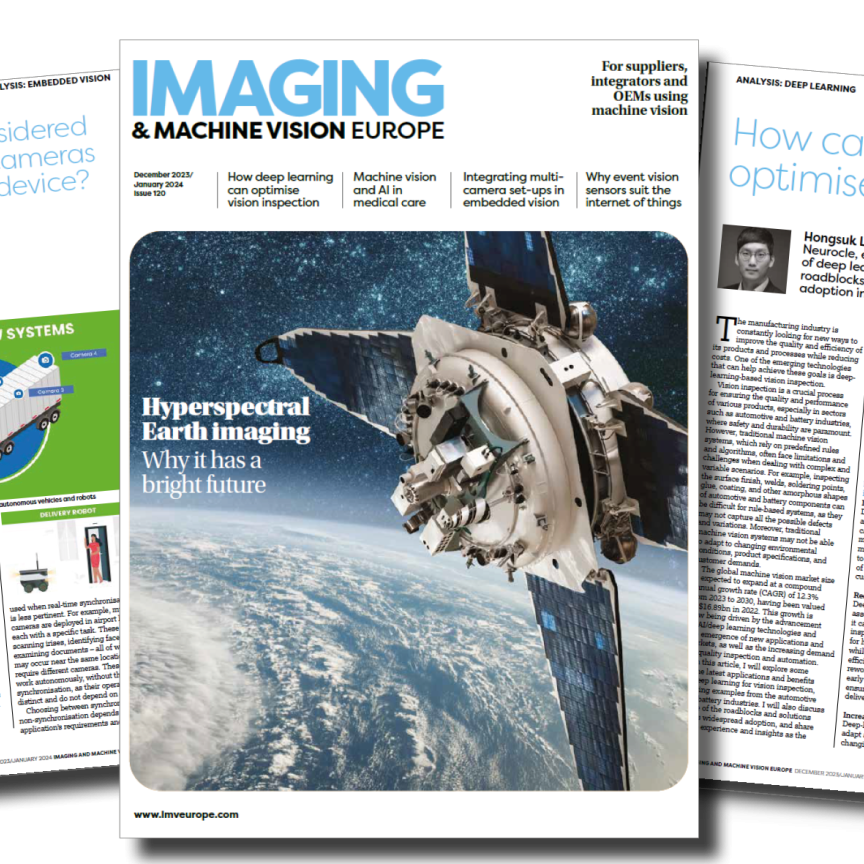FRAMOS, a global partner for vision technologies, was very satisfied with the results from Embedded World 2020, despite the moderate number of visitors at the tradeshow. At the FRAMOS booth, numerous visitors took the opportunity to learn about the sensor module Ecosystem and to marvel at the underwater version of the 3D depth camera, the D435e as well as a demo of the cubemos, AI 3D skeleton tracking software.
Dr. Andreas Franz, CEO of FRAMOS, says: “Embedded vision is an opportunity and paradigm shift for image processing companies like FRAMOS. Our numerous embedded projects for industry and consumer applications in recent years show that we are well positioned in this area. At the tradeshow it also became clear that developers do not only need embedded hardware components, it also indicated that there was a great demand for our AI applications - a rapidly growing area for FRAMOS.”
With the Ecosystem, FRAMOS solves the problem that for the latest sensors almost exclusively manufacturer's own evaluation boards are available. Thanks to the Ecosystem's expanded range of modules, vision engineers and developers can now evaluate many different and even the latest image sensors on open processor platforms, quickly create a proof of concept and then systematically develop it further.
Chris Barrett, CPO at FRAMOS, clarifies the concept: “With our flexible platform we support system developers in qualifying and integrating the image sensors required for their application more quickly and in obtaining the entire image sensor subsystem from one source. Using this system will allow customers to try before they buy and to know they have an effective solution long before they go into production.”
FRAMOS has been in partnership with Sony for over 30 years with a focus on image sensors for embedded vision, M-OLED micro-displays, and development boards. At our booth, we showed the Sony M-OLED and the holographic wave guide demos, and these was well received. The demos highlight the ease of evaluating and integrating the latest micro-display technology.
With the Intel RealSense relationship, FRAMOS showed the easy to integrate 3D depth cameras and modules that are optional for autonomous devices such as robots, drones, other “seeing” machines, and devices. For example, the D435e 3D depth camera which runs on Intel RealSense technology was presented with an underwater version demo, this was a real-eye catcher for all visitors.
During a live presentation, FRAMOS demonstrated the new D415e depth camera along with the cubemos AI Skeleton Tracking SDK - a technology for 2D and 3D detection of people and their posture. 3D skeleton tracking is used in interactive education, sports, motion analysis, entertainment, gaming, and healthcare. Skeleton tracking functionality can be performed on all common platforms. The FRAMOS spin-off cubemos presented a specially developed SDK for this purpose, with which skeleton tracking can be integrated into the customer's application in as little as 30 minutes.
Embedded World in Nuremberg is the world's leading international tradeshow for embedded systems and the industry meeting place for developers and decision-makers. Machine vision has been represented for quite a few years now with its own section and has grown due to the embedded vision trend. The FRAMOS team of experts presented its embedded portfolio and gave an overview of the highlights from image sensors, modules, 3D solutions displays and optics.
Sensor modules
FRAMOS has also expanded its sensor module ecosystem with Sony CMOS sensors. With high sensitivity, resolution, and processing speeds, the new sensors are suitable for surveillance and inspection tasks in light-critical conditions as well as factory automation applications. Even in low light, they enable imaging with low noise and a high dynamic range for detailed video and image analysis. FRAMOS offers both sensors on its proprietary sensor modules (FSM).
The new FRAMOS sensor modules FSM-IMX462C and FSM-IMX485C each have a Sony high-resolution colour sensor with 2.9 µm pixels and a resolution of 2 MP and 8 MP respectively. High sensitivity and further dark current reductions are achieved using Sony’s own super high conversion gain (SHCG) technology. SHCG pixels produce a far higher voltage than conventional image sensors even from the tiniest charge (in low incident light). This yields a much stronger signal in the analogue domain. The very good signal-to-noise ratio (SNR1 value) enables outstanding picture quality even in the moonlight.
In addition, the IMX462LQR-C sensor has a significantly higher near-infrared sensitivity (SHCG+NIR). This makes it ideal for IR-illuminated applications, e.g. in surveillance. The digital overlap (DOL) HDR option on both sensors allows up to three exposures to be taken with minimal latency. These can be combined into one HDR image. Especially in difficult, highly dynamic light conditions (e.g. daylight with shadows), the whole scene is captured with more clearly. Both sensors are equipped with an electronic rolling shutter with variable exposure time.
The IMX462LQR-C on the FSM-IMX462C sensor module is a Full HD sensor with a resolution of 1920 x 1080 pixels (2.13 MP) and a diagonal of 6.46 mm (1/2.8"). At full resolution, it achieves a frame rate of 120 fps (at 10 bits). In contrast, the IMX485LQJ-C on the FSM-IMX485C sensor module is a 4K image sensor with a resolution of 3840 x 2160 pixels (8.3 MP) and a diagonal of 12.86 mm (1/1.2"). It delivers frame rates of 60 fps (at 12 bits) or 90 fps (at 10 bits). Aside from surveillance tasks, both sensors are also suitable for all kinds of advanced vision systems.
André Brela, Product Manager at FRAMOS, discusses the expansion of the sensor module ecosystem with the new Sony sensors: “Visually recording our environment is now part of everyday life in many places. The ability to capture image data reliably in difficult lighting situations, with fast movements in dynamic environments, is a specific critical factor that affects the performance of downstream algorithms. Non-existent data cannot be compensated for arbitrarily by artificial intelligence. With the new SHCG pixels, Sony has made another leap forward in image capture. Sony remains unbeaten in terms of pixel performance for wide-scale applications.”

